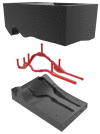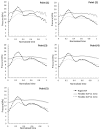Pressure Analysis in Rigid and Flexible Real Arteriovenous Fistula with Thickness Variation In Vitro
- PMID: 37367274
- PMCID: PMC10299082
- DOI: 10.3390/jfb14060310
Pressure Analysis in Rigid and Flexible Real Arteriovenous Fistula with Thickness Variation In Vitro
Abstract
An arteriovenous fistula (AVF) is the access most recommended by several authors. However, its manufacture and use can cause several problems in the short, medium and long term. The study of fluid dynamics related to the structure of the AVF can provide information necessary for the reduction of these problems and a better quality of life for patients. The present study analyzed pressure variation in a rigid and flexible (thickness variation) model of AVFs manufactured based on patient data. A computed tomography was performed from which the geometry of the AVF was removed. This was treated and adapted to the pulsatile flow bench. Bench tests with simulation of systolic-diastolic pulse showed higher pressure peaks in the rigid AVF followed by the flexible model with 1 mm thickness. The inflection of the pressure values of the flexible AVF in relation to the rigid one was observed, being more expressive in the flexible AVF of 1 mm. The 1 mm flexible AVF presented an average pressure close to the physiological one and a smaller pressure drop, showing that this AVF model presents the best condition among the three to serve as a basis for the development of an AVF substitute.
Keywords: arteriovenous fistula; flexible; pressure pulse; rigid.
Conflict of interest statement
The authors declare no conflict of interest.
Figures









Similar articles
-
In vitro hemodynamic model of the arm arteriovenous circulation to study hemodynamics of native arteriovenous fistula and the distal revascularization and interval ligation procedure.J Vasc Surg. 2014 May;59(5):1410-7. doi: 10.1016/j.jvs.2013.04.055. Epub 2013 Jul 9. J Vasc Surg. 2014. PMID: 23845661
-
Analyses of hemodialysis arteriovenous fistula geometric configuration and its associations with maturation and reintervention.J Vasc Surg. 2021 May;73(5):1778-1786.e1. doi: 10.1016/j.jvs.2020.09.033. Epub 2020 Oct 20. J Vasc Surg. 2021. PMID: 33091518 Free PMC article.
-
Hypoxia and hypoxia-inducible factors promote the development of neointimal hyperplasia in arteriovenous fistula.J Physiol. 2021 Apr;599(8):2299-2321. doi: 10.1113/JP281218. Epub 2021 Mar 19. J Physiol. 2021. PMID: 33608879 Free PMC article.
-
Gender differences in vascular access in hemodialysis patients in the United States: developing strategies for improving access outcome.Gend Med. 2007 Sep;4(3):193-204. doi: 10.1016/s1550-8579(07)80040-4. Gend Med. 2007. PMID: 18022587 Review.
-
Oxidative stress: An essential factor in the process of arteriovenous fistula failure.Front Cardiovasc Med. 2022 Aug 11;9:984472. doi: 10.3389/fcvm.2022.984472. eCollection 2022. Front Cardiovasc Med. 2022. PMID: 36035909 Free PMC article. Review.
Cited by
-
Adjusting blood redistribution to suppress flow disturbances of hemodialysis arteriovenous fistula: a computational fluid dynamics analysis.Front Bioeng Biotechnol. 2025 Mar 20;13:1551993. doi: 10.3389/fbioe.2025.1551993. eCollection 2025. Front Bioeng Biotechnol. 2025. PMID: 40182996 Free PMC article.
References
-
- Types of Arteriovenous Fistulas. [(accessed on 19 July 2022)]; Available online: https://www.ncbi.nlm.nih.gov/books/NBK493195/
Grants and funding
LinkOut - more resources
Full Text Sources

